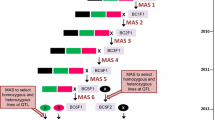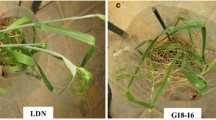Abstract
Crenate broomrape (Orobanche crenata) is the major constraint for pea cultivation in the Mediterranean Basin and Middle East. Cultivation of resistant varieties would be the most efficient, economical and environmentally friendly way to control this parasite. However, little resistance is available within cultivated pea. Promising sources of resistance have been identified in wild peas but their use in breeding programs is hampered by the polygenic nature of the resistance. The identification of molecular markers linked to the resistance would allow tracking of the underlying genes, facilitating their introgression into pea cultivars. The main objective of this study was the identification of genomic regions associated with resistance to O. crenata. A RIL (Recombinant Inbred Lines) population derived from a cross between a resistant accession of the wild pea Pisum sativum ssp. syriacum, and a susceptible pea variety was screened for resistance to O. crenata under field conditions during two seasons. In addition, resistance reactions at different stages of the O. crenata infection cycle were assessed using a Petri dish method. The approach allowed the identification of four Quantitative Trait Loci (QTL) associated with field resistance, assessed as the number of emerged broomrape shoots per pea plant under field conditions. These identified QTLs explained individually from 10 to 17% of the phenotypic variation. In addition QTLs governing specific mechanisms of resistance, such as low induction of O. crenata seed germination, lower number of established tubercles per host root length unit, and slower development of tubercles were also identified. Identified QTLs explained individually from 8 to 37% of the variation observed depending on the trait. Host plant aerial biomass and root length were also assessed and mapped. Both traits were correlated with the level of O. crenata infection and three out of the four QTLs controlling resistance under field conditions co-localized with QTLs controlling plant aerial biomass or root length. The relationship observed among these traits and resistance is discussed.





Similar content being viewed by others
References
Aalders AJG, Pieters R (1987) Resistance in Vicia fabae to Orobanche crenata: true resistance versus hidden susceptibility. Euphytica 36:227–236
Akhtouch B, Muñoz-Ruz J, Melero-Vara J, Fernández-Martínez J, Dominguez J (2002) Inheritance of resistance to race F of broomrape in sunflower lines of different origins. Plant Breed 121:266–268
Bernhard RH, Jensen JE, Andreasen C (1998) Prediction of yield loss caused by Orobanche spp. in carrot and pea crops based on the soil seedbank. Weed Res 38:191–197
Burstin J, Marget P, Huart M, Moessner A, Mangin B, Duchene C, Desprez B, Munier-Jolain N, Duc D (2007) Developmental genes have pleiotropic effects on plant morphology and source capacity, eventually impacting on seed protein content and productivity in pea. Plant Physiol 44:468–781
Churchill GA, Doerge RW (1994) Empirical threshold values for quantitative trait mapping. Genetics 198:963–971
Díaz R, Satovic Z, Román B, Rubiales D, Cubero JI, Torres AM (2005) QTL analysis of broomrape resistance in faba bean (Vicia faba L.). Proceedings of XL Croatiam symposium on Agriculture. Faculty of Agriculture, Zagreb, Croatia
Domínguez J (1996) R-41, a sunflower restored inbred line, carrying two genes for resistance against a highly virulent Spanish population of Orobanche cernua. Plant Breed 115:203–204
FAOSTAT data (2005) http://faostat.fao.org/
Fernández-Aparicio M, Sillero JC, Pérez-de-Luque A, Rubiales D (2008) Identification of sources of resistance to crenate broomrape (Orobanche crenata) in Spanish lentil (Lens culinaris) germplasm. Weed Res 48(1):85–94
Fondevilla S, Satovic Z, Rubiales D, Moreno MT, Torres AM (2008) Mapping of quantitative trait loci for resistance to Mycosphaerella pinodes in Pisum sativum subsp. syriacum. Mol Breed 21:439–454
Gurney AL, Slate J, Press MC, Scholes JD (2006) A novel form of resistance in rice to the angiosperm parasite Striga hermonthica. New Phytol 169:199–208
Haussmann BIG, Hess DE, Omanya GO, Reddy BVS, Welz HG, Geiger HH (2001) Major and minor genes for stimulation of Striga hermonthica seed germination in sorghum, and interaction with different Striga populations. Crop Sci 41:1507–1512
Hoagland DR, Arnon DI (1950) The water-culture method for growing plants without soil. University California Experimental Station Circular 347
Ish-Shalom-Gordon NR, Jacobsohn R, Cohen Y (1993) Inheritance of resistance to Orobanche cumana in sunflower. Phytopathology 83:1250–1252
Joel DM, Hershenhorn Y, Eizenberg H, Aly R, Ejeta G, Rich PJ, Ransom JK, Sauerborn J, Rubiales D (2007) Biology and management of weedy root parasites. In: Janick J (ed) Horticultural reviews, vol 33. Wiley, New York, pp 267–350
Johnson AW, Rosebery G, Parker C (1976) A novel approach to Striga and Orobanche control using synthetic germination stimulants. Weed Res 16:223–227
Korashi AA, El Borollosy MM, Hassa EA, Abo El-Suoud MR, El-Deen Z, Koraim A (1996) Hosts of Orobanche spp. and yield losses in delta and upper Egypt. In: Moreno MT et al (eds) Advances in parasitic plant research. Junta de Andalucía, Sevilla, pp 487–493
Kosambi DD (1994) The estimation of map distance from recombination values. Ann Eugen 12:172–175
Lander ES, Botstein D (1989) Mapping mendelian factors underlying quantitative trait using RFLP linkage maps. Genetics 121:185–199
Lander ES, Green P, Abramson J, Barlow A, Dali MJ, Lincoln DE, Newburg L (1987) MAPMAKER: an interactive computer program for constructing genetic linkage maps of experimental and natural populations. Genomics 1:174–181
Loridon K, McPhee K, Morin J, Dubreuil P, Pilet-Nayel ML, Aubert G, Rameau C, Baranger A, Coyne C, Lejeune-He`naut I, Burstin J (2005) Microsatellite marker polymorphism and mapping in pea (Pisum sativum L.). Theor Appl Genet 111:1022–1031
Mabsoute L, Saadaoui EM (1996) Acquis de recherche sur le parasitisme des légumineuses alimentaires au Maroc: synthèse bibliographique. Al Awamia 92:55–67
Moreno Marquez V (1947) El jopo (Orobanche crenata Forrks.) y las siembras tardías de habas. Boletín de Patología Vegetal y Entomología Agrícola 15:97–108
Pérez-De-Luque A, Jorrín J, Cubero JI, Rubiales D (2005) Resistance and avoidance against Orobanche crenata in pea (Pisum spp.) operate at different developmental stages of the parasite. Weed Res 45:379–387
Pérez-de-Luque A, González-Verdejo CI, Lozano MD, Dita MA, Cubero JI, González-Melendi P, Risueño MC, Rubiales D (2006a) Protein cross-linking, peroxidase and β-1, 3-endoglucanase involved in resistance of pea against Orobanche crenata. J Exp Bot 57:1461–1469
Pérez-de-Luque A, Lozano MD, Cubero JI, González-Melendi P, Risueño MC, Rubiales D (2006b) Mucilage production during the imcompatible interaction between Orobanche crenata and Vicia sativa. J Exp Bot 57:931–942
Pérez-Vich B, Akhtouch B, Knapp SJ, Leon AJ, Velasco L, Fernández-Martínez JM, Berry ST (2004) Quantitative trait loci for broomrape (Orobanche cumana Wallr.) resistance in sunflower. Theor Appl Genet 109:92–102
Prioul S, Frankewitz A, Deniot G, Morin G, Baranger A (2004) Mapping of quantitative trait loci for partial resistance to Mycosphaerella pinodes in pea (Pisum sativum L.) at the seedling and adult plant stages. Theor Appl Genet 108:1322–1334
Ramaiah KV (1987) Control of Striga and Orobanche species. A review. In: Weber HC, Forstreuter W (eds) Parasitic flowering plants. Philipps-Universität, Marburg, pp 637–664
Román B, Torres AM, Rubiales D, Cubero JI, Satovic Z (2002) Mapping of quantitative trait loci controlling broomrape (Orobanche crenata Forks.) resistance in faba bean (Vicia faba L.). Genome 45:1057–1063
Rubiales D, Sillero JC, Moreno MT (1999) Broomrape (Orobanche crenata) as a major constraint for pea cultivation in Southern Spain. In: Cubero JI, Moreno MT, Rubiales D, Sillero JC (eds) Resistance to Orobanche: the state of the art. Junta de Andalucíıa, Sevilla, pp 83–89
Rubiales D, Pérez-de-Luque A, Cubero JI, Sillero JC (2003a) Crenate broomrape (Orobanche crenata) infection in field pea cultivars. Crop Prot 22:865–872
Rubiales D, Pérez-de-Luque A, Joel DM, Alcántara C, Sillero JC (2003b) Characterization of resistance in chickpea to crenata broomrape (Orobanche crenata). Weed Sci 51:702–707
Rubiales D, Moreno MT, Sillero JC (2005) Search for resistance to crenate broomrape (Orobanche crenata) in pea germplasm. Genet Resour Crop Evol 52:853–861
Rubiales D, Pérez-de-Luque A, Fernández-Aparicio M, Siller JC, Román B, Kharrat M, Khalil S, Joel DM, Riches C (2006) Screening techniques and sources of resistance against parasitic weeds in grain legumes. Euphytica 147:187–199
Sauerborn J, Masri H, Saxena MC, Erskine W (1987) A rapid test to screen lentil under laboratory conditions for susceptibility to Orobanche. Lens Newsletter 14:15–16
Sillero JC (1999) Faba Bean breeding for resistance to diseases. PhD Thesis. University of Córdoba, Spain
Sillero JC, Rubiales D, Moreno MT (1999) New sources of resistance to broomrape (Orobanche crenata) in a collection of Vicia species. In: Cubero JI, Moreno MT, Rubiales D, Sillero J (eds) Resistance to Orobanche: the state of the art. Junta de Andalucía, Consejería de Agricultura y Pesca, Sevilla, pp 45–54
Sillero JC, Cubero JI, Fernández-Aparicio M, Rubiales D (2005) Search for resistance to crenate broomrape (Orobanche crenata) in Lathyrus. Lathyrus Lathyrism Newsletter 4:7–9
Tar’an B, Warkentin T, Somers DJ, Miranda D, Vandenberg A, Balde S, Woods S, Bing D, Xue A, DeKoeyer D, Penner G (2003) Quantitative trait loci for lodging resistance, plant height and partial resistance to Mycosphaerella blight in field pea (Pisum sativum L.). Theor Appl Genet 107:1482–1491
Tennant D (1975) A test of a modified line intersect method of estimating root length. J Ecol 63:995–1001
Ter Borg S (1999) Broomrape resistance in faba bean: what do we know? In: Cubero JI, Moreno MT, Rubiales D, Sillero J (eds) Resistance to Orobanche: the state of the art. Junta de Andalucía, Consejería de Agricultura y Pesca, Sevilla, pp 25–41
Valderrama MR, Román B, Satovic Z, Rubiales D, Cubero JI, Torres AM (2004) Locating genes associated with Orobanche crenata resistance in pea. Weed Res 44:323–328
Wang S, Basten CJ, Gaffney P, Zeng Z-B (2005) Windows QTL cartographer version 2.5. Statistical genetics. North Carolina State University, Raleigh
Weeden NF, Ellis THN, Timmerman-Vaughan GM, Swiecicki WK, Rozov SM, Berdnikov VA (1998) A consensus linkage map for Pisum sativum. Pisum Genetics 30:1–4
Wegmann K, Von Elert E, Harloff HJ, Stadler M (1991) Tolerance and resistance to Orobanche. In: Wegmann K, Musselman LJ (eds) Progress in Orobanche research. Proceeding of a workshop on Orobanche, pp 318–321
Zeng ZB (1994) Precision mapping of quantitative trait loci. Genetics 136:1457–1468
Acknowledgments
We thank INIA for providing a grant to the senior author and projects AGL2005-10181 and AGL2008-01239 for financial support.
Author information
Authors and Affiliations
Corresponding author
Rights and permissions
About this article
Cite this article
Fondevilla, S., Fernández-Aparicio, M., Satovic, Z. et al. Identification of quantitative trait loci for specific mechanisms of resistance to Orobanche crenata Forsk. in pea (Pisum sativum L.). Mol Breeding 25, 259–272 (2010). https://doi.org/10.1007/s11032-009-9330-7
Received:
Accepted:
Published:
Issue Date:
DOI: https://doi.org/10.1007/s11032-009-9330-7




